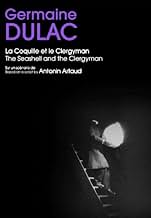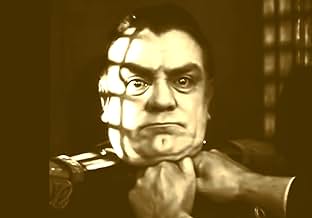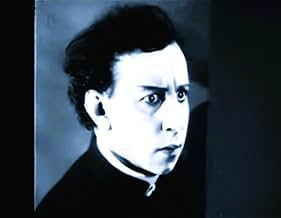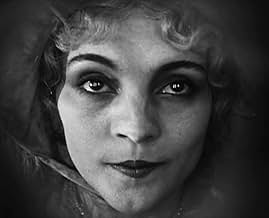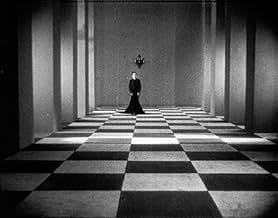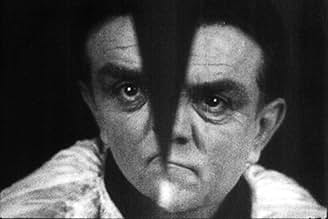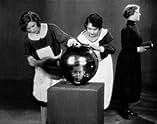AVALIAÇÃO DA IMDb
7,0/10
2,4 mil
SUA AVALIAÇÃO
Adicionar um enredo no seu idiomaObsessed with a general's woman, a clergyman has strange visions of death and lust, struggling against his own eroticism.Obsessed with a general's woman, a clergyman has strange visions of death and lust, struggling against his own eroticism.Obsessed with a general's woman, a clergyman has strange visions of death and lust, struggling against his own eroticism.
- Direção
- Roteiristas
- Artistas
- Direção
- Roteiristas
- Elenco e equipe completos
- Produção, bilheteria e muito mais no IMDbPro
Avaliações em destaque
The predecessor of Un Chien Andalou and directed by the lone woman filmmaker of her time, La Coquille et le Clergyman is one of the most celebrated of French avant-garde movies of the '20s, partly because Antonin Artaud wrote the script, partly because the British censor of the time banned it with the legendary words 'If this film has a meaning, it is doubtless objectionable'. Artaud was reputedly unhappy with Dulac's realization of his scenario, and it's true that the story's anti-clericalism (a priest develops a lustful passion that plunges him into bizarre fantasies) is somewhat undermined by the director's determined visual lyricism. But the fragmentation of the narrative and the innovative imagery remain provocative, and the film is of course fascinating testimony to the currents of its time.
Stumbled upon this on Wikipedia:
quote: The British Board of Film Censors famously reported that the film was "so cryptic as to be almost meaningless. If there is a meaning, it is doubtless objectionable"
I wonder if the fact that this was the work of a female director influenced people of that time to dismiss the importance of this particular piece.
Just with a little research we can find Dulac's political views about gender, thus for me is quite clear the intention behind this film, and perhaps we can have second guesses about the symbols used in it, but her questioning the church, the state and male sexuality and the positioning of women at that time was groundbreaking. Which is sad, because if not but that huge dismissal, this could be catalogued easily as the very first surrealist film of all times, BEFORE Buñuel-Dalí's 'A Chien Andalou' and don't get me wrong I enjoyed it, but even Buñuel stated that he didn't put any meaning behind it, it was just a dream put into film so why the double standard?
Loved the ideas behind The Seashell and the Clergyman, it was great to bump into this film, for it was an amusing discovery!
quote: The British Board of Film Censors famously reported that the film was "so cryptic as to be almost meaningless. If there is a meaning, it is doubtless objectionable"
I wonder if the fact that this was the work of a female director influenced people of that time to dismiss the importance of this particular piece.
Just with a little research we can find Dulac's political views about gender, thus for me is quite clear the intention behind this film, and perhaps we can have second guesses about the symbols used in it, but her questioning the church, the state and male sexuality and the positioning of women at that time was groundbreaking. Which is sad, because if not but that huge dismissal, this could be catalogued easily as the very first surrealist film of all times, BEFORE Buñuel-Dalí's 'A Chien Andalou' and don't get me wrong I enjoyed it, but even Buñuel stated that he didn't put any meaning behind it, it was just a dream put into film so why the double standard?
Loved the ideas behind The Seashell and the Clergyman, it was great to bump into this film, for it was an amusing discovery!
At first there seems to be some kind of science experiment. A potion is put from a vial into a pan by what looks to be a clergyman (?) and then a man in a General's uniform uses a sword to chop it down. The camera makes things look woozy, the frame and composition becoming warped and undone, like the feeling of going under or being drunk. We follow the Clergyman as he runs down a street (on his knees?) and then walks down a hall. There's also a woman, and the General is still there, but then... there's visions. He goes to another place mentally, perhaps, seeing a ship, water, waves, all sort of images that seem connected but disconnected at the same time. There's a room full of maids sweeping, then lined in formation. And then that 'Seashell' of the title - revealing (what else) boobs.
So much went into this film, the Seashell and the Clergyman, directed by Germain Dulac and written by one of the real-deal surrealists (and actor) Antonin Artuad, that I'm sure I could watch this five more times - and would want to - and get a different take on it each time. This preceded Un chien Andalou by a year, and yet I feel like these filmmakers and Bunuel/Dali were part of the same movement; whether Bunuel and Dali saw this film before they made their excursion is arguable, and I'd be curious to find out for sure (certainly the one moment where I went "Oh!" was when the clergyman reveals the seashell for the breasts - a similar shot happens in Andalou).
Yet it's impossible to make too many comparisons, because each surrealist goes about in their own way. This one has impressive, uncanny visual effects work for the time, mostly in ways of warping the frame - possibly by stretching the frame in post, or slow-motion in-camera. Then there's the simple act of one person being in a shot, and then the next someone popping up next to the actor through the jump-cut. Smoke is used to great effect at times, especially when violence occurs. Cinema tricks are plenty here, but what I took from the film is how it looks at the inner dream/mind-scape of such a person as the Clergyman. And perhaps this was Artaud's intention, maybe not (the British censors weren't sure what this was, but banned it anyway, possibly a gut reaction).
Why I read into it this way I'm not sure... actually, that's not totally true. It must be noted that this was directed not by a man (as Andalou) but a woman, and I think there's a different take on this because of that - a shot like the one with all the maids bustling about the room, doing their work almost like automatons, that has a woman's touch in a kind of satirical/absurd way. When I watch this film, I see a lot of sexualized imagery, a lot of repression, and it boiling over the surface. The version I watched on YouTube - with a great musical accompaniment that made it feel like a horror film in moments - had the air of an eerie land of nightmare and terror. The best surrealistic shorts has the stream-of-consciousness feel (think Deren or Bunuel or Man Ray), but this one especially has images that perhaps to make sense, in a Dream Logic sort of way, and if one were to follow the images as descriptions on paper, I'm sure it would read more like a poem.
It's a massively successful, deranged effort that can mean many things, but I have a feeling there's something strange about that Man of the Cloth...
So much went into this film, the Seashell and the Clergyman, directed by Germain Dulac and written by one of the real-deal surrealists (and actor) Antonin Artuad, that I'm sure I could watch this five more times - and would want to - and get a different take on it each time. This preceded Un chien Andalou by a year, and yet I feel like these filmmakers and Bunuel/Dali were part of the same movement; whether Bunuel and Dali saw this film before they made their excursion is arguable, and I'd be curious to find out for sure (certainly the one moment where I went "Oh!" was when the clergyman reveals the seashell for the breasts - a similar shot happens in Andalou).
Yet it's impossible to make too many comparisons, because each surrealist goes about in their own way. This one has impressive, uncanny visual effects work for the time, mostly in ways of warping the frame - possibly by stretching the frame in post, or slow-motion in-camera. Then there's the simple act of one person being in a shot, and then the next someone popping up next to the actor through the jump-cut. Smoke is used to great effect at times, especially when violence occurs. Cinema tricks are plenty here, but what I took from the film is how it looks at the inner dream/mind-scape of such a person as the Clergyman. And perhaps this was Artaud's intention, maybe not (the British censors weren't sure what this was, but banned it anyway, possibly a gut reaction).
Why I read into it this way I'm not sure... actually, that's not totally true. It must be noted that this was directed not by a man (as Andalou) but a woman, and I think there's a different take on this because of that - a shot like the one with all the maids bustling about the room, doing their work almost like automatons, that has a woman's touch in a kind of satirical/absurd way. When I watch this film, I see a lot of sexualized imagery, a lot of repression, and it boiling over the surface. The version I watched on YouTube - with a great musical accompaniment that made it feel like a horror film in moments - had the air of an eerie land of nightmare and terror. The best surrealistic shorts has the stream-of-consciousness feel (think Deren or Bunuel or Man Ray), but this one especially has images that perhaps to make sense, in a Dream Logic sort of way, and if one were to follow the images as descriptions on paper, I'm sure it would read more like a poem.
It's a massively successful, deranged effort that can mean many things, but I have a feeling there's something strange about that Man of the Cloth...
If you are looking for a twin movie to go alongside Luis Buñuel's surrealist head-scratcher Un Chien Andalou, then look no further than this film. The Seashell and the Clergyman shares that famous movie's bizarre, often indecipherable, imagery as well as anti-clerical subversion and frank sexuality. I can't say I understood what was going on. I'm not sure if I was even supposed to. But like Buñuel's film this movie is all about surrealism, it doesn't always have logical meaning. An image such as the clergyman crawling through the streets of Paris is something that is not easily forgotten and the film in general operates in the same way as a dream. The best way to appreciate a film such as this is to sit back and take in the imaginative visuals and dream-like ambiance that is specific to these ancient silent movies. If you are at all interested in 20's surrealist cinema then this is a film I would definitely recommend. Also, the fact that a woman made such a provocative film all those years ago is especially surprising seeing as female artists have always struggled with having their voice heard.
Germaine Dulac was no ordinary French female film-director. She was Avante-Garde and radical in her film-making which did not include a laugh track or sound. Everything was visual and her silent classics were visuals to be appreciated and understood by all of us. There was a reason that so many people saw the same movie numerous times during that era. First, it was very inexpensive and second, you needed to revisit and see the film again and again until you saw it completely. That's how films once were, films were visual masterpieces and in Dulac's case, she helped reshape the role of women in films to include more than just being an actress. She was the producer, director, and writer. She was many things to many people on film sets in France. Film was new and fresh invention that those of us who seek to learn more about art should watch Dulac's classic.
Você sabia?
- CuriosidadesThe British Board of Film Censors banned this film in the UK in 1927, saying, "This film is so obscure as to have no apparent meaning. If there is a meaning, it is doubtless objectionable."
- ConexõesEdited into Women Who Made the Movies (1992)
Principais escolhas
Faça login para avaliar e ver a lista de recomendações personalizadas
Detalhes
- Data de lançamento
- País de origem
- Central de atendimento oficial
- Idioma
- Também conhecido como
- The Seashell and the Clergyman
- Locações de filme
- Empresa de produção
- Consulte mais créditos da empresa na IMDbPro
- Tempo de duração
- 40 min
- Cor
- Mixagem de som
- Proporção
- 1.33 : 1
Contribua para esta página
Sugerir uma alteração ou adicionar conteúdo ausente

